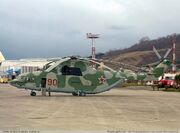The Mil Mi-26 (NATO reporting name: Halo) is a Soviet heavy lift cargo helicopter. In service with civilian and military operators, it is the largest and most powerful helicopter ever to have gone into production.
The Mi-26 supply helicopter is expensive, slow, big and easy to hit with missiles. This helicopter is much slower, bigger and carries 2-3 more units than the the Super Chinook. The Mi-26 has the advantage of carrying a much heavier cargo at the cost of speed. It should be used to supply frontline units with supplies. It should be used with caution, and its large size means it is easy to spot and shoot down.
Due to its carrying capacity, and the fact that it can resupply any supply unit smaller than itself, i.e all of them, 2 of these working together can act as a slightly smaller portable FOB, deploy it in a safe zone, close to the front lines, and then ferry supplies to units with cargo trucks. This way your supplies will not be vulnerable to surface to air missiles, and if they run out you can quickly fly them back to your F.O.B's, resupply them, and bring them back to the safe zone. Bear in mind that you must be careful, losing one, or both of them, can be disastrous as they cost a notable amount of points and carry, combined, nearly a full FOB worth of supplies.
History

The Mi-26 was designed as a heavy-lift helicopter for military and civil use, and was to replace earlier Mi-6 and Mi-12 heavy lift helicopters, with twice the cabin space and payload of the Mi-6, then the world's largest and fastest production helicopter. The primary purpose was to move military equipment like 13 metric ton (29,000 lb) amphibious armored personnel carriers, and mobile ballistic missiles, to remote locations after delivery by military transport planes such as the Antonov An-22 or Ilyushin Il-76.
The first Mi-26 flew on 14 December 1977. The first production aircraft was rolled out on 4 October 1980.One production aircraft was destroyed during pre-delivery single-engine emergency landing procedure testing, but there were no casualties. Development was completed in 1983, and the Mi-26 was in Soviet military and commercial service by 1985.
The Mi-26 was the first factory-equipped helicopter with an eight-blade rotor. It is capable of flight in the event of power loss by one engine (depending on aircraft mission weight) thanks to an engine load sharing system. While it is only slightly heavier than the Mi-6, the Mi-26 can lift up to 20 metric tons (44,000 lb). It is the second largest and heaviest helicopter ever constructed, after the experimental V-12. The tail rotor has about the same size and thrust of the MD 500 main rotor.